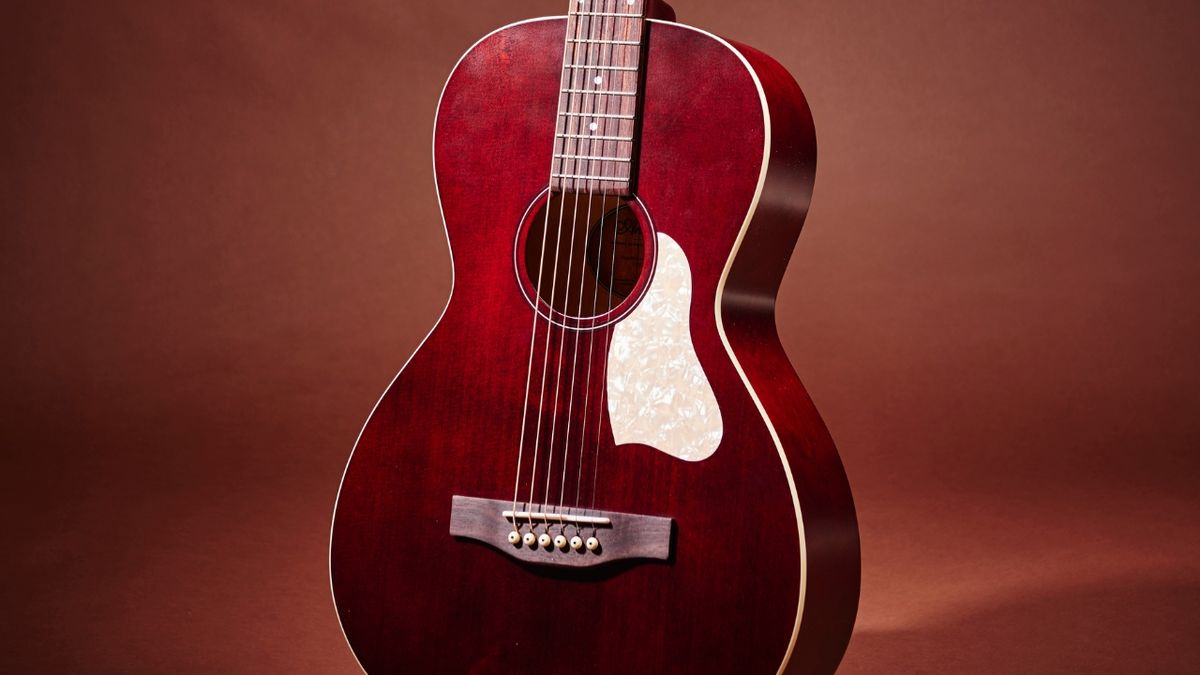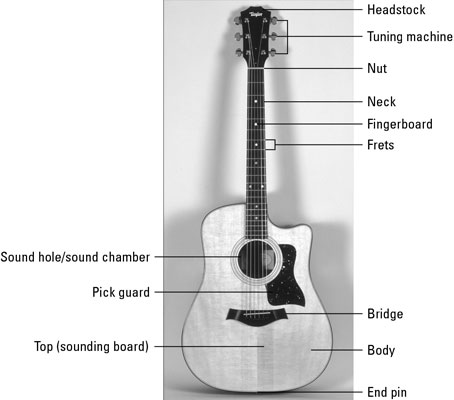Picture this: you’re strumming away on your trusty guitar, belting out notes like a rock star. But have you ever stopped to think about the intricate inner workings of this six-stringed beauty? Join me as we peel back the layers of the guitar’s structure and function in all its stringy glory. Grab your magnifying glass and let’s dive into the world of frets, necks, and tuners – oh my!
Contents
- 1 The Anatomy of a Guitar: Understanding Its Physical Structure
- 2 Diving Into the Different Types of Guitars: Acoustic, Electric, and Beyond
- 3 Examining the Guitar’s Core Components: From Frets to Sound Hole
- 4 How String Gauge and Material Influence Guitar Sound and Playability
- 5 The Role of the Body Shape and Wood Type in a Guitar’s Tone
- 6 Innovations in Guitar Design: Bridging Tradition and Technology
- 7 Unlocking the Mystery of Guitar Electronics: Pickups, Pots, and Switches
- 8 FAQs
- 9 Rock on, Guitar Enthusiasts!
The Anatomy of a Guitar: Understanding Its Physical Structure
Ever wondered what makes a guitar tick? Let’s dive into the inner workings of this stringed beauty and unravel its secrets!
First up, we have the body of the guitar. This is where all the magic happens (and where you can pretend you’re a rockstar). The body comes in various shapes and sizes, from the classic dreadnought to the sleek and sexy cutaway. It’s like the guitar’s stylish outfit, except it’s made of wood. Plus, it’s the perfect spot for strumming your heart out or impressing your friends with a killer solo.
Next, we have the neck of the guitar. This long, slender piece is what connects the body to the headstock. It’s like the bridge between two worlds, allowing you to navigate the fretboard like a pro. With frets to guide your fingers and strings to serenade your ears, the neck is where the real fun begins. Just watch out for those pesky barre chords!
Finally, we have the headstock. This is where all the tuning magic happens, thanks to those handy tuning pegs. It’s like the control center of the guitar, ensuring each string is in perfect harmony. So next time you’re rocking out, take a moment to appreciate the intricate physical structure of your trusty six-stringed companion. It may just inspire you to pick up a new riff or two!

Diving Into the Different Types of Guitars: Acoustic, Electric, and Beyond
So you’ve decided to take the plunge and learn to play the guitar. Congratulations! But before you strum your first chord, it’s important to understand the different types of guitars out there. Think of it like choosing a partner in crime – you want to find the one that’s just right for you. Let’s dive into the world of guitars and explore the possibilities.
First up, we have the trusty acoustic guitar. This is your classic, no-frills instrument that’s perfect for serenading your crush or singing around the campfire. With its hollow body and steel strings, the acoustic guitar produces a warm, earthy sound that will make you feel like you’re one with nature. Plus, you don’t need to worry about lugging around amps and cords – just grab your guitar and go!
Next, we have the electric guitar - the rockstar of the guitar world. With its sleek body and electric pickups, this bad boy is ready to make some noise. Plug it into an amp, crank up the volume, and let the power chords rip. Want to sound like a guitar god? Just add some distortion and wah-wah pedal, and you’ll be shredding like there’s no tomorrow. Warning: may cause spontaneous headbanging.
But wait, there’s more! Beyond the acoustic and electric guitars, there are all sorts of unique and exotic instruments waiting to be explored. From twelve-string guitars to resonator guitars, baritone guitars to flamenco guitars, the world of guitars is vast and diverse. So go forth, young guitarist, and explore the endless possibilities. Who knows? You may just find your perfect match.

Examining the Guitar’s Core Components: From Frets to Sound Hole
So you think you know everything there is to know about guitars, huh? Well, buckle up my friend, because we are about to take a deep dive into the fascinating world of the guitar’s core components.
Let’s start with the frets. Those little metal strips that run along the neck of the guitar may seem insignificant, but they play a crucial role in determining the pitch of the notes you play. Each fret represents a specific note, and when you press down on a string behind a fret, you change the length of the vibrating portion of the string, which in turn changes the pitch. It’s like magic, but with more math involved.
Next up, we have the sound hole. This humble opening on the body of the guitar may not look like much, but it’s responsible for projecting sound waves out into the world. Without the sound hole, all you’d hear when you strummed a chord would be a sad little whisper. So next time you serenade someone with your guitar playing, be sure to give a shout-out to the unsung hero of the instrument – the sound hole.
And let’s not forget about the strings. Those slender pieces of metal may look innocent enough, but in reality, they are the essence of the guitar. Without strings, a guitar would just be a fancy wooden box. But with strings, it’s a gateway to musical nirvana. So remember, treat your strings with care and they’ll reward you with sweet sounds for years to come.

How String Gauge and Material Influence Guitar Sound and Playability
Have you ever wondered how the size and material of your guitar strings can make a huge difference in how your guitar sounds and feels to play? Well, wonder no more, because I’m here to break it down for you in a way that’s both informative and entertaining.
Let’s start with string gauge. The gauge of a string refers to its thickness, with thicker strings typically producing a richer, fuller sound, while thinner strings offer greater flexibility and easier playability. So, if you’re a shredder who loves to wail on your guitar, you’ll probably want to opt for heavier gauge strings. But if you’re more of a delicate fingerpicker, lighter gauge strings might be more your speed.
Next, let’s talk about string material. The material of your guitar strings can also greatly impact the sound and playability of your instrument. For example, steel strings are known for their bright, crisp tone, while nylon strings offer a warmer, mellower sound. So, if you’re going for that classic acoustic folk sound, you might want to go with nylon strings. But if you’re looking to rock out with some serious distortion, steel strings are the way to go.
Ultimately, finding the right string gauge and material for your guitar is a personal choice that depends on your playing style and musical preferences. But remember, don’t be afraid to experiment and try out different combinations until you find the perfect match that makes your guitar sing and your fingers dance.

The Role of the Body Shape and Wood Type in a Guitar’s Tone
When it comes to the perfect guitar tone, body shape and wood type play a crucial role in creating that sweet sound that makes you want to keep playing all day long. Let’s dive into the world of guitar construction and find out how these factors affect the overall sound of your instrument.
First off, the body shape of a guitar can dramatically impact its tone. From the curvy, hourglass shape of a classic acoustic guitar to the sleek, ergonomic design of a modern electric guitar, the body shape dictates how the sound waves resonate within the instrument. A larger body shape tends to produce a deeper, richer tone, while a smaller body shape offers a brighter, more treble-heavy sound.
Now, let’s talk about the wood type used in guitar construction. Different woods have unique tonal qualities that can significantly influence the overall sound of a guitar. For example, mahogany is known for its warm, mellow tone, while maple offers a bright, articulate sound. And let’s not forget about the legendary richness of rosewood and the punchy, midrange-focused sound of alder.
So, next time you pick up your guitar, take a moment to appreciate the intricate dance of body shape and wood type that brings your instrument to life. Whether you’re strumming an acoustic ballad or shredding a metal solo, remember that the perfect tone is a delicate balance of craftsmanship and creativity. Keep rocking, and let your guitar’s unique voice shine through!
Innovations in Guitar Design: Bridging Tradition and Technology
Ever wanted to strum a guitar that can also make you a cup of coffee? That might be a stretch, but innovations in guitar design have definitely taken us to some exciting new places. From flashy futuristic designs to high-tech features, the possibilities are endless!
Imagine a guitar that can tune itself with just the flick of a switch. No more wrestling with those pesky tuning pegs – just hit a button and voila! Or how about a guitar that doubles as a USB drive, where you can store all your chord charts, lyrics, and music recordings? Talk about convenience!
But it’s not all about the tech – some designers are finding ways to blend modern innovation with classic materials and craftsmanship. Picture a guitar made from reclaimed wood with a built-in LED display. A perfect marriage of tradition and technology, don’t you think?
So whether you’re a purist who loves the warmth of a vintage guitar or a tech-savvy musician looking for the latest gadgets, there’s something out there for everyone. The guitar world is evolving, and we’re all along for the ride!
Unlocking the Mystery of Guitar Electronics: Pickups, Pots, and Switches
Ever wonder how the sweet sounds of your guitar actually make their way to your ears? It’s all thanks to pickups, pots, and switches – the unsung heroes of the guitar electronics world. Let’s dive into the mysteries of these tiny components and uncover their secrets.
First up, pickups. These little guys are like the ears of your guitar, picking up the vibrations of the strings and turning them into electrical signals. Without pickups, your guitar would be as silent as a mime with laryngitis. Different types of pickups, like single-coil and humbuckers, can drastically change the tone of your guitar – so choose wisely!
Next, we have pots (no, not the kind you cook with). Pots, short for potentiometers, are volume and tone knobs that control the flow of electricity in your guitar. Think of them as the gatekeepers of your instrument’s sound – turn them up for a screaming solo or dial them back for a mellow ballad.
Finally, switches. These nifty little contraptions determine which pickups are being used and how they are connected. Want that snappy bridge pickup tone? Flip the switch. Feeling nostalgic for some neck pickup warmth? Switch it up, literally. With the right combination of pickups, pots, and switches, you can unlock a world of sonic possibilities for your guitar. So go forth, brave guitarist, and conquer the mysteries of guitar electronics!
FAQs
What makes up the guitar’s structure?
Well, think of it as a magical sandwich. You’ve got the body (the bread), the neck (the filling), and the headstock (the crust). And let’s not forget about the strings, which are like the peanut butter and jelly that hold everything together.
How does the structure of the guitar affect its sound?
Oh, it’s like a symphony of awesomeness. The shape and material of the body can impact the resonance and tone of the guitar. The length and thickness of the neck can also affect how the vibrations travel through the instrument. It’s like each part is a musical superhero, working together to create beautiful music.
What are the essential functions of each part of the guitar?
The body is there to house the sound hole (where the sound escapes), the bridge (where the strings are anchored), and the pickups (for electric guitars). The neck is where you’ll find the frets (to change pitch) and the tuning pegs (to adjust tension). And the headstock? Well, that’s just there to look cool and hold the tuning pegs in place.
How do different types of guitars vary in structure and function?
Oh boy, where do I even begin? Acoustic guitars have a hollow body for natural amplification, while electric guitars have pickups and often a solid body for minimal feedback. And then you’ve got bass guitars, resonator guitars, 12-string guitars…the list goes on. Each one has its own unique structure and function to cater to different styles of music.
Rock on, Guitar Enthusiasts!
As we wrap up our journey into the intricate world of the guitar’s structure and function, we hope you’ve gained a newfound appreciation for this marvelous instrument. From the humble beginnings of its wooden body to the intricate wiring of its pickups, the guitar is truly a marvel of engineering and artistry.
So next time you pick up your trusty six-stringed companion, remember to strum with purpose and jam out like a true rockstar. And who knows, maybe one day you’ll be the one dissecting the ins and outs of this legendary instrument for future generations to marvel at.
Keep on rocking, guitar enthusiasts! And remember, the world is your stage.



